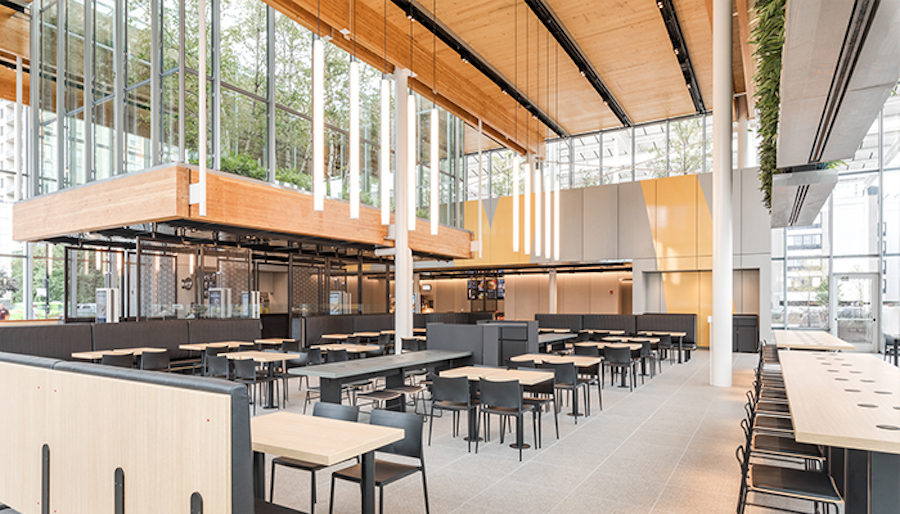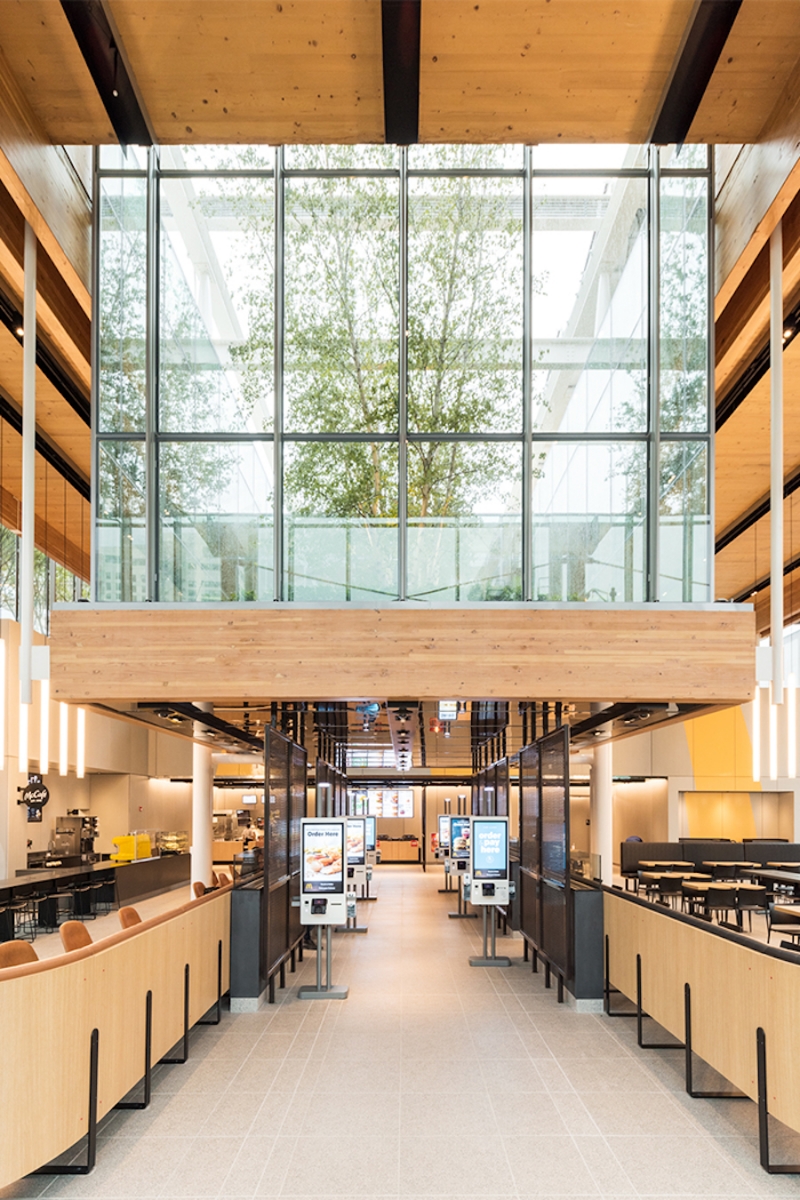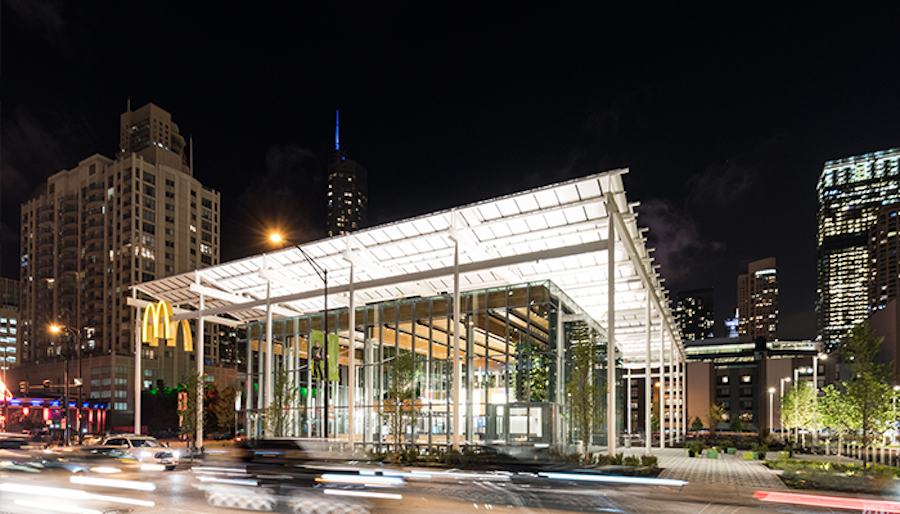Last month, McDonald’s opened its brand new flagship at Clark and Ontario, replacing the rock 'n' roll-themed restaurant that had occupied the location since 1983. One of the most famous locations of the fast-food chain, the original Rock 'n' Roll McDonald’s was memorialized in song by Wesley Willis (and will be forever tainted by its association with another Chicago musician, R. Kelly, who allegedly picked up underage girls at the restaurant). Morgan Spurlock even featured it in his documentary Super Size Me. The structure, rebuilt in 2005 to coincide with the 50th anniversary of the first franchised McDonald’s in Des Plaines, also had a small museum display on the upper level and a rock 'n' roll-themed exhibit in an adjacent building.
All of that is now gone. No rock 'n' roll. No Ronald McDonald. Not even a PlayPlace. Cutting ties with nostalgia, the fast-food company is moving ahead with its “Experience of the Future” initiative, which will modernize most of the 14,000 U.S. McDonald’s locations in the next few years. And while you have to respect the commitment to sustainable architecture, this new flagship is austere and technology-based — and may leave some patrons feeling cold.
The 19,000-square-foot steel and timber building, smaller than its predecessor, heralds McDonald’s green era with an eco-friendly design by Ross Barney Architects, best known for the new Morgan Street and Cermak-McCormick Place CTA stations as well as the multi-phase expansion of the Chicago Riverwalk. The new flagship also corresponds with the company moving its headquarters from suburban Oak Brook to West Loop, replacing yet another iconic local site: Oprah Winfrey’s Harpo Studios.
Standing across Ontario Street from the new McDonald's, one can get a full view of the edifice. It’s a clever idea: A modern interpretation of one of the McDonald brothers’ original drive-up hamburger stands.
But one wonders whether the architects were also paying homage to the Apple Store on Michigan Avenue. Moving from Clark to the Ohio side of the building, the glass all but disappears, leaving a gray-paneled rectangular box resembling a MacBook. (Joking aside, Barney’s firm did in fact help Foster + Partners with the new Apple flagship, so if the team is copying anyone, it's copying itself.) The resemblance speaks to a trend: Corporate chains moving toward open, airy spaces and away from stale, plasticized ones. It’s an attempt to bring in more young consumers, who are said to be abandoning such chains.

Once upon a time, McDonald’s’ famed Golden Arches played a starring role in the restaurant’s image; they were even used as a structural element in the Rock 'n' Roll McDonald’s. Now, the shrunken logo is nearly hidden beneath the building's exterior corner rafters. And given the Arches' unintended status as a symbol of capitalism and globalization, it’s no wonder the chain seems to be retreating from them. It’s a move away from Mickey D’s past.
The Rock 'n' Roll McDonald’s kitschiness once fit perfectly into its stretch of River North, next to Hard Rock Cafe, Rainforest Cafe, Portillo’s, and the late Ed Debevic’s. But as a number of the area’s surrounding buildings get replaced by high rises, this suburbanized block of River North feels more out of place than ever. One wonders if the new McDonald’s won’t even stand out by next year, dwarfed by taller structures popping up all over its neighborhood.
In fact, you could argue that McDonald’s is mimicking these glass towers. Its sleek modernist appearance mirrors the area’s changing character. It’s not just the chain restaurants at Clark and Ontario that make the area feel suburban, but the one-story Walgreens, the BP gas station, and even the Ohio House Motel. These neighbors will likely too disappear. McDonald’s at least recognizes that it needs to adapt to its surrounding environment.
One space that seems like a step backwards is the restaurant's parking lot. While the architects cut the amount of parking spaces by one-third, it still feels prominent and unnecessary in the middle of a bustling neighborhood, especially so close to Michigan Avenue. I wish they had gotten rid of it completely. A pro: Instead of asphalt, this outside space is built out of gray concrete bricks, which match the seating area and exterior of the building. The lot also apparently collects and recirculates rainwater.
The plaza, which now includes outdoor seating and more than 70 trees, is a big step toward a pedestrian-friendly space. Yet, during a recent visit on a bright, sunny day, not a single person was sitting outside. One reason: the seating consists of brightly colored boxes rather than traditional chairs. Who wants to sit and eat on that? The area is just not very welcoming.
What is attractive is the building's roof, which is fitted with more than one thousand solar panels. The structure is alive with native grasses, a floating garden of ferns, and white birch trees that project down into the interior space, a main focal upon entry. It's also a clever marketing scheme: During my recent visit, a number of people pointed up to the trees and took pictures and videos, which will undoubtedly end up on their favorite social media platoforms.

Another social media trap: the drive-thru, which along with the parking lot signifies McDonald's' continued entanglement with car culture. This area is adorned with trees, inspiring passengers to snap away at the nature. But I do wonder: As green architecture becomes more ubiquitous in the coming years, will McDonald's' glass arboretum in the sky continue to grab people's attention?
The restaurant's modernization isn't just apparent in its architecture. There are touchscreens, self-serve kiosks, wireless charging stations, and even free WiFi. The checkout area is hidden from the entrance like an afterthought, while the kiosks command prime real estate beneath the floating garden. Tucked away, the counter looks small and claustrophobic, to the degree I felt bad for the employees stuck behind it. The focus on self-service leans into the growing trend of automation in fast-casual restaurants — and the loss of human interaction that comes along with it.
At the restaurant's press preview, 42 Ward Alderman Brendan Reilly said, “I defy you to find another McDonald’s on Earth as beautiful as this one" — a high expectation not entirely grounded in reality. There are good ideas at the new McDonald's, but they don't always deliver. The design is eye-catching for now, but over time, the glass box motif will inevitably become just one of many in the area. I don’t see it in the same category as Chicago landmarks like the Wrigley Building, Aqua, or University of Chicago’s Joe and Rika Mansueto Library. In fact, in another 20 or 30 years, we may be asking ourselves what was so unique about McDonald's 2.0. We might also be checking out yet another renovated flagship.



